#Psychographic Segmentation
Explore tagged Tumblr posts
Text
Understanding Behavioral and Psychographic Segmentation: A Smarter Approach to Targeting
In today’s competitive market, understanding your audience goes beyond basic demographics. Behavioral Segmentation and Psychographic Segmentation are powerful marketing tools that help brands connect with customers on a deeper level. While behavioral segmentation focuses on user actions like purchase history, loyalty, or usage rate, psychographic segmentation dives into values, interests, lifestyle, and personality traits. This combination allows businesses to craft more relevant, personalized campaigns that truly resonate. By integrating both behavioral and psychographic insights, marketers can predict future buying patterns, increase customer satisfaction, and drive higher ROI. Whether you're in e-commerce, SaaS, or retail, leveraging these segmentation strategies ensures you're reaching the right audience with the right message at the right time. This article explores how to implement both segmentation methods effectively and why they are essential for modern marketing success.
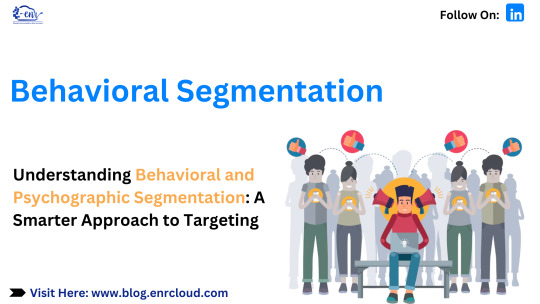
0 notes
Text
What Is Market Research: Methods, Types & Examples
Learn about the fundamentals of market research, including various methods, types, and real-life examples. Discover how market research can benefit your business and gain insights into consumer behavior, trends, and preferences.
#Market research#Methods#Types#Examples#Data collection#Surveys#Interviews#Focus groups#Observation#Experimentation#Quantitative research#Qualitative research#Primary research#Secondary research#Online research#Offline research#Demographic analysis#Psychographic analysis#Geographic analysis#Market segmentation#Target market#Consumer behavior#Trends analysis#Competitor analysis#SWOT analysis#PESTLE analysis#Customer satisfaction#Brand perception#Product testing#Concept testing
0 notes
Text

How can RideBoom leverage customer segmentation to tailor its pricing strategy for different user groups?
Here are some ways RideBoom can leverage customer segmentation to tailor its pricing strategy for different user groups:
Demographic Segmentation: RideBoom can segment its customers based on factors like age, income, and location. This can help them offer different pricing options tailored to the needs and willingness to pay of each demographic group. For example, they could offer discounted rates for students or seniors, while charging higher prices for business travelers. Behavioral Segmentation: RideBoom can analyze customer usage patterns, such as frequency of rides, preferred ride types (e.g. economy vs. premium), and peak vs. off-peak usage. This can inform dynamic pricing strategies that adjust rates based on demand, rewarding loyal/frequent riders with discounts while charging higher prices during peak hours or for last-minute bookings. [1] Psychographic Segmentation: RideBoom can segment customers based on their lifestyle, values, and priorities. This could involve offering specialized packages or add-ons tailored to different customer segments, such as eco-conscious riders, families, or nightlife enthusiasts. Pricing can be adjusted accordingly to match the preferences of each group. [2] Tiered Pricing: RideBoom can implement a tiered pricing structure with different service levels and corresponding prices. This could include basic economy rides, premium rides with additional features, and even luxury options. Customers can then choose the level of service and pricing that best fits their needs and budget. [3] Loyalty Programs: By offering loyalty programs, RideBoom can segment customers based on their engagement and reward the most valuable users with exclusive pricing benefits, such as discounted subscription plans or credits for frequent riders. This can help increase customer retention and lifetime value. [3] Overall, RideBoom can leverage a combination of these customer segmentation strategies to develop a more nuanced and effective pricing approach that caters to the diverse needs and preferences of its user base, ultimately driving increased revenue and customer satisfaction.
#delhi rideboom#rideboom app#rideboom#ola cabs#rideboom taxi app#biketaxi#uber#ola#uber driver#uber taxi
61 notes
·
View notes
Text
GPS—Here we go again, there were 20,189 devices.
Still a large crowd but not even close to the 30,000 quoted in Denver newspapers nor the 34,000 quoted by Bernie Sanders and AOC.
84% of the devices present had attended 9 or more Kamala Harris rallies, antifa/blm, pro-Hamas, pro-Palestinian protests, 31% had attended over 20.
For more insight into what data we also look at in addition to GPS location data would be demographic and psychographic data using over 6,000 different databases, i.e., like the Bureau of Labor Statistics (BLS), Pew Research Center, market research firms like YouGov, Experian, specialized tools like ESRI's Tapestry Segmentation, consumer surveys, social media platforms like 𝕏, Facebook, Linkedin.
Demographic data includes basic characteristics like age, gender, income, education level, occupation, marital status, family size, ethnicity, and where people live (e.g., city, state).
Psychographic data dives deeper into people's lifestyles, values, attitudes, interests, personality traits, social class, activities, and how they make purchasing decisions.
For example, it might show if someone values sustainability, enjoys outdoor activities, participates in community activism.
While demographic data is straightforward, psychographic data can reveal sensitive personal details, like beliefs even life goals.
Additionally, by cross pollinating each device with other devices regularly within close proximity to the target device we are able to build a detailed profile for each target. 90% of those in the above 84% were likely working with one of these five groups and is the reason for their presence.
Once again, this is based a very sophisticated algorithm that looks at the behavioral metrics for each device, including the physical 1:1 proximity to leaders and paymasters from these groups in the past.
Disruption Project, Rise & Resist, Indivisible Project, Troublemakers and the Democratic Socialists of America.
Each receives money from ActBlue and at least three, via USAID.
Disruption Project: Legal status is unclear, likely operating illegally.
Rise & Resist: 501c4 non-profit
Indivisible Project: 501c4 non-profit
Troublemakers: Legal status is for profit.
Democratic Socialists of America: 501c4 non-profit
11 notes
·
View notes
Text
However, leftist corporate media failed to fact-check the socialist for misinformation or disinformation. Others did—using a sophisticated algorithm to analyze data from all smartphone devices at the event—and found the numbers were severely overinflated.
Many of the attendees were probably bussed in and had a history of participating in Antifa/BLM, pro-Hamas, and pro-Palestinian protests. The Democratic Party is known for bussing activists through NGO networks to events to fill seats—a tactic repeatedly used throughout Kamala Harris' 2024 presidential campaign trail to create fake hype.
Data analyst Tony Seruga exposed just how staged the latest Democratic Party rally was, revealing their ongoing attempts to manipulate public perception with inorganic crowds made up mainly of DEI activists rather than genuine grassroots supporters:
GPS—Here we go again, there were 20,189 devices. Still a large crowd but not even close to the 30,000 quoted in Denver newspapers nor the 34,000 quoted by Bernie Sanders and AOC. 84% of the devices present had attended 9 or more Kamala Harris rallies, antifa/blm, pro-Hamas, pro-Palestinian protests, 31% had attended over 20. For more insight into what data we also look at in addition to GPS location data would be demographic and psychographic data using over 6,000 different databases, i.e., like the Bureau of Labor Statistics (BLS), Pew Research Center, market research firms like YouGov, Experian, specialized tools like ESRI's Tapestry Segmentation, consumer surveys, social media platforms like 𝕏, Facebook, Linkedin. Demographic data includes basic characteristics like age, gender, income, education level, occupation, marital status, family size, ethnicity, and where people live (e.g., city, state). Psychographic data dives deeper into people's lifestyles, values, attitudes, interests, personality traits, social class, activities, and how they make purchasing decisions. For example, it might show if someone values sustainability, enjoys outdoor activities, participates in community activism. While demographic data is straightforward, psychographic data can reveal sensitive personal details, like beliefs even life goals. Additionally, by cross pollinating each device with other devices regularly within close proximity to the target device we are able to build a detailed profile for each target. 90% of those in the above 84% were likely working with one of these five groups and is the reason for their presence.
Once again, this is based a very sophisticated algorithm that looks at the behavioral metrics for each device, including the physical 1:1 proximity to leaders and paymasters from these groups in the past. Disruption Project, Rise & Resist, Indivisible Project, Troublemakers and the Democratic Socialists of America. Each receives money from ActBlue and at least three, via USAID.
Disruption Project: Legal status is unclear, likely operating illegally. Rise & Resist: 501c4 non-profit Indivisible Project: 501c4 non-profit Troublemakers: Legal status is for profit. Democratic Socialists of America: 501c4 non-profit
11 notes
·
View notes
Text
Proven Marketing Tactics for Small Business Success
Marketing is the lifeblood of any enterprise, especially small groups seeking to grow and compete in a crowded market. Without powerful advertising strategies, even the satisfactory products or services can pass overlooked. Unlike huge companies, small companies often operate with restrained budgets and resources. Therefore, they need clever, price-effective, and measurable strategies to advantage visibility and develop step by step.
Best marketing strategies for small business

This article explores numerous marketing techniques that are especially effective for small agencies, combining traditional strategies with modern digital tools.
1. Understand Your Target Audience
The basis of all advertising begins with know-how your clients. Define your target marketplace based totally on:
Demographics: Age, gender, profits stage, education
Geographics: Where they stay or paintings
Psychographics: Lifestyle, pursuits, and values
Behavioral trends: Buying conduct, logo loyalty, product utilization
Creating a purchaser persona enables you tailor your messaging, offers, and channels greater correctly. For instance, in case you're concentrated on university college students, Instagram and TikTok is probably better platforms than electronic mail advertising or print media.
2. Build a Strong Brand Identity
A recognizable and straightforward emblem builds lengthy-time period customer loyalty. Your brand includes:
Logo and design: Consistent shades, fonts, and imagery
Tone of voice: Formal, informal, funny, and so on.
Even a one-man or woman enterprise blessings from sturdy branding. For example, a nearby baker who uses eco-friendly packaging can emblem themselves as “inexperienced” and attract environmentally-conscious customers.
Three. Create a Professional Website
A internet site is your 24/7 digital storefront. It should be:
Mobile-friendly and fast
Easy to navigate
Linked for your social media pages
Equipped with touch paperwork or chat help
Use platforms like WordPress, Wix, or Shopify to create low priced, attractive websites without requiring technical expertise.
Four. Utilize Local search engine marketing
If you’re a nearby commercial enterprise, optimizing your on-line presence for local searches is critical. Start by using:
Claiming and verifying your Google Business Profile
Encouraging satisfied clients to depart reviews
Using local key phrases (e.G., “nice salon in Patna”)
Getting indexed in neighborhood directories and maps
5. Leverage Social Media Marketing
Social media structures offer unfastened and paid tools to interact your target audience and construct a community.
Facebook & Instagram: Great for promotions, memories, and visible content
LinkedIn: Best for B2B organizations
YouTube: Ideal for tutorials, product demos, and at the back of-the-scenes content
X (previously Twitter): Good for quick updates, client interplay
Use content material calendars to time table posts always and engage with followers through polls, contests, and comments.
6. Content Marketing: Educate and Add Value
Rather than simply promoting, content material advertising goals to teach and construct accept as true with. Examples encompass:
Blog posts: Informative articles in your internet site
E-books & Guides: Offer beneficial records in alternate for electronic mail addresses
Videos: Product demonstrations, testimonials, or storytelling
Infographics: Shareable visuals explaining complicated topics
Content advertising improves search engine marketing, establishes authority, and builds long-term trust.
7. Email Marketing
Email remains one of the most price-powerful channels for small corporations. Use it to:
Send newsletters
Announce promotions or new merchandise
Re-engage inactive customers
Request remarks
Tools like Mailchimp, Sendinblue, and ConvertKit allow smooth automation and list segmentation. Ensure your emails offer fee, no longer just commercials.
Eight. Referral and Loyalty Programs
Your glad clients can be your excellent marketers. Encourage them to refer friends or family with the aid of offering:
Discounts
Free products
Loyalty points
#digital marketing#online and offline sales#online and offline business#method of small business#Best marketing strategies for small business
3 notes
·
View notes
Text
New Business Marketing Tips and Tricks for Success
Starting a new business can be an exhilarating adventure, but it also comes with its fair share of challenges, especially in the competitive landscape of today's marketplace. To stand out and thrive, effective marketing is crucial. Here are four essential marketing tips and tricks to help your new business succeed:
Define Your Target Audience and Create Customer Personas:
One of the first steps in crafting a successful marketing strategy for your new business is to identify and understand your target audience. Who are your ideal customers, and what are their needs, preferences, and pain points? Creating customer personas can help you visualize and humanize your audience, making it easier to tailor your marketing efforts effectively.

Start by conducting market research to gather data about your potential customers. Analyze demographics, psychographics, and behavior patterns to create detailed customer personas. These personas should include information like age, gender, income, interests, and pain points.
Once you have a clear understanding of your target audience, customize your marketing messages and strategies to resonate with them. Craft compelling content, advertisements, and promotions that address their specific needs and desires. By speaking directly to your ideal customers, you'll increase the chances of building meaningful connections and driving conversions.
Leverage the Power of Digital Marketing:
In the digital age, online presence and digital marketing are indispensable for any new business. Here are some essential digital marketing strategies to consider:
a. Build a User-Friendly Website: Your website is often the first point of contact for potential customers. Ensure that it is well-designed, easy to navigate, and mobile-responsive. Optimize it for search engines (SEO) to improve your visibility in search results.
b. Content Marketing: Create valuable and relevant content that educates, entertains, or solves problems for your target audience. Blog posts, videos, infographics, and social media updates can all be part of your content marketing strategy.

c. Social Media Marketing: Identify the social media platforms where your audience is most active and engage with them there. Develop a content calendar and use a mix of organic and paid content to reach a wider audience.
d. Email Marketing: Build and nurture an email list to stay in touch with your customers. Send personalized and relevant content, offers, and updates to keep them engaged and informed.
e. Pay-Per-Click Advertising (PPC): Consider running targeted PPC campaigns on platforms like Google Ads and Facebook Ads to reach potential customers actively searching for your products or services.
Emphasize Customer Relationships and Engagement:
In a competitive market, building and maintaining strong customer relationships is vital. Consider these strategies to enhance customer engagement:
a. Provide Exceptional Customer Service: Respond promptly to inquiries and address customer concerns with care. Happy customers are more likely to become loyal advocates for your brand.
b. Personalization: Use customer data and segmentation to personalize your marketing messages and offers. People appreciate tailored experiences that cater to their unique preferences.

c. Encourage User-Generated Content: Encourage customers to share their experiences with your products or services on social media or review platforms. User-generated content can build trust and credibility.
d. Loyalty Programs: Reward repeat customers with loyalty programs, discounts, or exclusive access to new products or services. Loyalty programs can foster long-term relationships and increase customer retention.
Monitor, Analyze, and Adapt:
Marketing is not a one-size-fits-all endeavor. To continually improve your strategies, track key performance indicators (KPIs) and adapt based on the data:
a. Use Analytics Tools: Employ tools like Google Analytics, social media insights, and email marketing metrics to monitor the performance of your marketing efforts.
b. A/B Testing: Experiment with different marketing approaches and compare their results through A/B testing. This allows you to refine your strategies over time.

c. Stay Informed: Keep up with industry trends, competitors, and evolving customer preferences. Stay open to adjusting your marketing plan as needed.
In conclusion, successful marketing for a new business involves understanding your audience, utilizing digital strategies, fostering customer relationships, and staying adaptable. By implementing these tips and tricks, your new business can navigate the competitive landscape and carve out its own path to success.
#seo#online marketing#digitalmarketing#marketing agency#learn digital marketing#digital marketing service#seo marketing#digital marketing course#digital marketing#seo expert#business success#business marketing#marketing tips
25 notes
·
View notes
Text
Building Success with an Advanced Marketing Framework
Competitive digital world, understanding and implementing an Advanced Marketing Framework is crucial for brands aiming to capture, retain, and grow a strong customer base. A well-structured framework provides the roadmap for navigating dynamic customer needs, optimizing marketing efforts, and scaling business growth. By analyzing data, segmenting audiences, and delivering the right message at the right time, brands can engage customers and drive conversions effectively.
Understanding the Concept of an Advanced Marketing Framework
An Advanced Marketing Framework is a structured approach that combines strategies, tools, and analytics to enhance marketing effectiveness. It goes beyond traditional marketing methods, diving deeper into data-driven insights, real-time adjustments, and customer-centric tactics. Unlike basic frameworks, an advanced one integrates sophisticated techniques such as machine learning, behavioral segmentation, and cross-channel analysis to optimize results.
Creating an Advanced Marketing Framework is about harmonizing various elements, including customer data, brand messaging, channels, and feedback mechanisms, to offer a more cohesive experience across touchpoints. This approach increases brand loyalty and facilitates a seamless buyer journey from awareness to purchase.
Key Components of an Advanced Marketing Framework
Building an Advanced Marketing Framework requires more than just a few tweaks to traditional methods; it needs a holistic structure encompassing essential components:
1. Customer-Centric Approach
A customer-centric framework prioritizes the needs, desires, and behaviors of the target audience. By analyzing demographic, psychographic, and behavioral data, businesses can develop personalized campaigns that resonate with customers on a deeper level.
2. Data-Driven Insights
Data analytics is foundational to an Advanced Marketing Framework. With tools like Google Analytics, HubSpot, or more complex machine learning models, marketers can gain insights into customer behavior, engagement patterns, and conversion metrics. Leveraging data enables the fine-tuning of campaigns to maximize ROI and make informed decisions about where to allocate marketing resources.
3. Content Strategy and Personalization
Content remains a critical piece in engaging audiences. The Advanced Marketing Framework relies on content that is not only relevant but also tailored to individual customer segments. Personalization, such as dynamic emails, curated recommendations, or personalized landing pages, drives higher engagement and nurtures customer loyalty.
4. Omnichannel Marketing
In an Advanced Marketing Framework, omnichannel marketing ensures consistency across platforms, from email to social media to in-store experiences. Integrating channels allows for seamless transitions between touchpoints, enhancing the customer experience. This continuity helps brands reinforce messaging, nurture leads, and build stronger relationships with customers.
5. Automation and AI-Driven Strategies
Automation and artificial intelligence (AI) are game-changers in advanced marketing. Automated workflows can handle repetitive tasks, like sending follow-up emails or reminding customers about abandoned carts. AI-driven analytics provide deep insights into customer trends and forecast future behavior, making campaigns more targeted and efficient.
6. Continuous Optimization and Real-Time Adjustments
Unlike traditional frameworks, an Advanced Marketing Framework isn’t static. It requires constant optimization and real-time updates based on data analytics and customer feedback. A/B testing, conversion rate optimization, and performance monitoring are essential to ensure that campaigns are achieving their objectives and maximizing engagement.
7. Feedback and Adaptability
Customer feedback is an integral part of the Advanced Marketing Framework. Whether it’s through surveys, reviews, or social media comments, feedback helps brands understand customer sentiment, address concerns, and improve offerings.
Benefits of Implementing an Advanced Marketing Framework
Integrating an Advanced Marketing Framework offers substantial benefits:
Improved Customer Engagement: Personalized, data-driven strategies capture customer attention and keep them engaged across channels.
Higher Conversion Rates: By targeting the right audience with the right message, brands can enhance conversion rates and customer satisfaction.
Enhanced Efficiency: Automation and AI streamline operations, freeing up resources for creative, high-impact work.
Data-Backed Decisions: A reliance on data means that marketing decisions are well-informed and optimized for results.
Competitive Edge: Brands using an Advanced Marketing Framework stay ahead by adapting to customer preferences and market changes faster.
Getting Started with Your Advanced Marketing Framework
Creating and implementing an Advanced Marketing Framework might seem overwhelming, but starting with small steps can make a significant impact. Begin by clearly defining your target audience, outlining measurable objectives, and selecting the tools necessary for data analysis and automation.
Next, focus on omnichannel marketing strategies, ensuring your brand message is consistent across platforms. From here, experiment with content personalization and automation to enhance engagement. Remember to continually monitor and optimize your approach based on performance data and customer feedback.
2 notes
·
View notes
Text
If anyone interested in being a writer for WWE. 😂😂 I wouldn't suggest linking your tumblr account if you down the rabbit hole of fanfiction. Good luck to anyone that decides to do this. ❤️
WWE is looking for a new creative team member.
On Friday, WWE posted this new job opening for a writer/producer.
You can check out the official job description below:
Key Responsibilities:
* Develop clearly defined, yet emotionally sophisticated, characters for a diverse group of WWE Talent.
* Script descriptive, thought-provoking, captivating, and creative storylines for RAW, SmackDown, and select programming on the WWE Network
* Collaborate with a team of writers to build compelling stories that capture a global audience fitting multiple demographics
* Provide punch-up for specific scripted segments as well as review the totality of entire episodes for continuity and flow
* Incorporate consumer insights and social media to deliver impactful storylines that are consistent with the WWE brand and each Talent’s skills and history
* Weekly travel to our shows (RAW or Smackdown) & rotating travel to PPV’s (Pay-Per-View’s)
* Attend and contribute in creative writing team meetings every week at our Stamford, CT HQ
Qualifications:
* 5+ years of writing for TV, film or social media
* Producing and Directing experience a plus
* Professional TV staff experience in drama and comedy a plus
* Experience in Live TV production a plus
* Plugged into social media trends
* Previous experience working with On-Screen Talent, Creative Writers, and Producers
* Understanding of WWE’s audience (demographic and psychographic) a plus but not required
* BA/BS in Film, TV, Drama, Media Studies, Communications or similar field of study or validated experience in lieu of a degree
9 notes
·
View notes
Text
How does this Persona Chart work?
Persona charts are tools used to create fictional but representative profiles of target audience segments. These profiles help businesses and designers better understand their customers or users, which in turn can inform product development, marketing strategies, and user experience design. Here's a general outline of how persona charts typically work:
Research: The process begins with extensive research to gather information about the target audience. This can involve surveys, interviews, market research, and data analysis to identify common characteristics, behaviors, and preferences among potential users or customers.
Segmentation: Once you have gathered data, you can segment your audience into distinct groups based on shared traits. These traits might include demographics (age, gender, location), psychographics (lifestyle, values, interests), and behavioral patterns (buying habits, online behavior).
Persona Creation: For each segment, you create a persona – a fictional character that represents a typical member of that group. Each persona should have a name, a photo (stock or generated), and a detailed background story. This includes information such as age, occupation, goals, challenges, hobbies, and pain points.
Persona Attributes: Within the persona chart, you list the attributes and characteristics that define each persona. This might include things like:
Demographics: Age, gender, marital status, income, education, etc.
Psychographics: Values, attitudes, interests, and lifestyle.
Behavioral Information: Purchasing habits, online behavior, preferred communication channels, etc.
Goals and Pain Points: What the persona is trying to achieve and what obstacles they face.
Use in Decision-Making: Persona charts are valuable tools that can guide decision-making in various areas, such as product development, marketing, and user experience design. For example:
Product Development: Personas help teams design products and features that cater to the needs and preferences of their target audience.
Marketing: Personas inform marketing strategies, including content creation, messaging, and channel selection.
User Experience Design: Designers use personas to create user interfaces and experiences that resonate with the intended users.
Iterate and Update: As your business evolves or as you gather more data, it's essential to revisit and update your personas to ensure they remain accurate and relevant.
The effectiveness of persona charts depends on the quality of the research and the accuracy of the personas created. They can be powerful tools for aligning your strategies with the needs and wants of your target audience.
Check: https://astrology-seek.com/blog/persona-chart/
13 notes
·
View notes
Text
Creating Customer Persona
Hello, Urban Nest enthusiasts! 🌟
Understanding your customers is key to any successful business, and today we're diving deep into one of the most powerful tools for this: the customer persona. Whether you're just starting out or looking to refine your marketing strategy, creating a detailed customer persona can provide invaluable insights into who your customers are, what they need, and how you can best serve them.
What is a Customer Persona? 🤔
A customer persona (or buyer persona) is a semi-fictional representation of your ideal customer based on market research and real data about your existing customers. This persona helps you understand and connect with your target audience.
Why Do You Need a Customer Persona? 📈
Targeted Marketing: Crafting messages that resonate deeply with specific audience segments.
Product Development: Designing products that meet the actual needs of your customers.
Customer Experience: Enhancing every touchpoint to match customer expectations.
Efficiency: Streamlining marketing efforts and resource allocation by focusing on high-impact strategies.
How to Create a Customer Persona: A Step-by-Step Guide 📝
1. Gather Data 🗂️
Start with data collection. Use a mix of primary and secondary research to gather insights into your customers' demographics, behaviors, and preferences.
Primary Research:
Surveys and Polls
Interviews
Observations
Secondary Research:
Analytics
Industry Reports
2. Segment Your Audience 🎯
Identify common traits and behaviors among your customers to group them into segments. Consider factors like age, gender, location, income, education, lifestyle, and buying habits.
Example Segments for Urban Nest:
Budget-Conscious Students
Style Enthusiasts
Tech-Savvy Individuals
3. Define Your Persona's Characteristics 👤
Create a detailed profile for each segment, including:
Demographics: Age, gender, location, education, occupation, income.
Psychographics: Values, interests, lifestyle, personality traits.
Behavioral Insights: Shopping habits, product preferences, decision-making process.
Challenges and Pain Points: What problems does your persona face? How can your product solve them?
Example:
Name: Emily Thompson
Age: 20
Education: Junior at State University, majoring in Marketing
Location: Los Angeles, California
Income: $8,000 annually (part-time job)
Lifestyle: Busy student balancing work, school, and social life
Values: Creativity, individuality, sustainability
Challenges: Limited budget, small living space, time constraints
4. Develop Their Story 📚
Humanize your persona with a narrative that brings their profile to life. This story should reflect their daily experiences, motivations, and how they interact with your product.
Conclusion
Creating a customer persona is not a one-time task. Continuously update your personas with new insights and feedback to keep them relevant and effective. By understanding and connecting with your customers on a deeper level, you can build stronger relationships and create more impactful marketing strategies.
Now, it’s your turn! Have you created a customer persona for your business yet? Share your experiences or ask questions in the comments below!
3 notes
·
View notes
Text
Unveiling the 5 Ps Framework: A Complete Guide to Digital Marketing Mastery
In the ever-expanding realm of digital marketing, the key to success lies in a well-crafted strategy. One such framework that has proven invaluable is the 5 Ps framework. Originating from traditional marketing principles, this framework seamlessly transitions into the digital age, offering marketers a systematic approach to crafting and executing effective marketing campaigns.
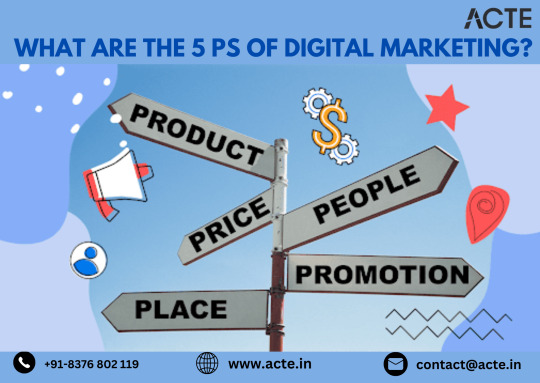
In this comprehensive guide, we'll delve into each of the 5 Ps – Product, Price, Place, Promotion, and People – and explore their application in the digital landscape.
1. Product: Understanding Your Offering
At the core of any marketing strategy is the product or service being offered. In digital marketing, comprehending your product goes beyond its features and specifications. It involves identifying its unique value proposition and how it addresses the needs and pain points of your target audience. Whether it's physical goods, digital services, or subscription-based offerings, a profound understanding of your product is essential for crafting compelling marketing messages and driving customer engagement.
2. Price: Determining the Right Value Proposition
Setting the appropriate price for your product or service is a delicate balance. In the digital era, consumers have access to a plethora of information and choices, making pricing decisions more critical than ever. Competitive pricing, value-based pricing, and dynamic pricing are just a few strategies digital marketers can utilize to capture market share and optimize profitability. By analyzing market trends, competitor pricing strategies, and customer preferences, marketers can identify the optimal price point that aligns with their business objectives and resonates with their target audience.
3. Place: Leveraging Digital Channels for Distribution
Gone are the days when "place" in marketing solely referred to physical locations. In today's digital landscape, "place" encompasses the multitude of online channels and platforms used for product distribution and sales. From e-commerce websites and mobile apps to social media platforms and online marketplaces, digital marketers have a wealth of options at their disposal. The key is to select the channels that effectively reach and engage your target audience. By leveraging digital channels strategically, marketers can expand their reach, enhance brand visibility, and drive sales in the fiercely competitive online marketplace.
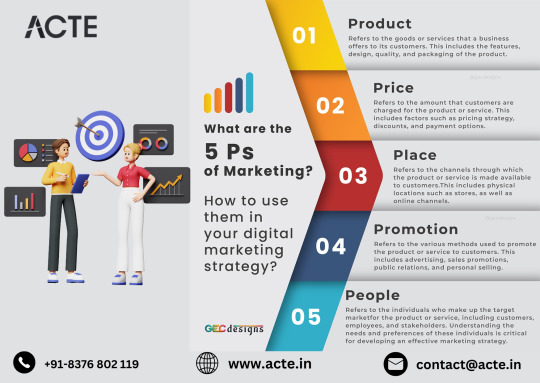
4. Promotion: Crafting Compelling Marketing Messages
Promotion is the driving force behind awareness, interest, and conversions. In digital marketing, the promotional landscape is vast and diverse, encompassing content marketing, social media marketing, email marketing, SEO, PPC advertising, influencer marketing, and more. The key is to develop cohesive and integrated promotional campaigns that resonate with your target audience across multiple touchpoints. By harnessing the power of storytelling, personalization, and data-driven insights, digital marketers can create compelling marketing messages that cut through the clutter and drive meaningful engagement with their brand.
5. People: Understanding Your Audience
At the heart of every successful marketing campaign lies a deep understanding of the target audience. In digital marketing, this entails creating detailed buyer personas that capture the demographics, psychographics, and online behavior of your ideal customers. By understanding their needs, preferences, pain points, and aspirations, marketers can tailor their messaging and offers to effectively address specific customer segments. Moreover, by leveraging data analytics and marketing automation tools, marketers can deliver personalized experiences that resonate with individual customers, fostering loyalty and repeat business.
In summary, the 5 Ps framework provides a holistic and structured approach to digital marketing strategy. By comprehending the interplay between Product, Price, Place, Promotion, and People, marketers can develop and execute effective marketing campaigns that drive results and achieve business objectives. In the dynamic and fast-paced world of digital marketing, mastering the 5 Ps is essential for staying competitive and driving growth in today's digital landscape.
#tech#training#digital marketing#digital marketing company#digital marketing course#email marketing#online marketing#search engine optimization#seo#seo services
3 notes
·
View notes
Text
Understanding Consumer Behavior in Marketing: Patterns, Types, and Segmentation
Explore the intricate world of consumer behavior in marketing. Uncover patterns, types, and segmentation strategies to gain valuable insights and tailor your marketing efforts effectively.
#Consumer behavior in marketing#Patterns in consumer behavior#Types of consumer behavior#Segmentation in marketing#Marketing strategies#Consumer psychology#Behavior patterns#Consumer preferences#Target audience#Customer segmentation#Buyer behavior#Market research#Marketing insights#Consumer trends#Demographic segmentation#Psychographic profiling#Marketing effectiveness#Consumer buying behavior#Market segmentation techniques#Customer segmentation strategies
0 notes
Text
Enhance Your Brand's Online Presence with Top-notch Social Media Marketing Services in Delhi
In today's digitally-driven world, a strong online presence is paramount for businesses aiming to thrive and succeed. Social media platforms have emerged as powerful tools that enable brands to connect, engage, and expand their reach to a broader audience. For businesses in Delhi, capitalizing on effective social media marketing services has become crucial to stay ahead in the competitive market landscape.
Welcome to WeboClimb, your professional SEO company in Delhi. As a top-rated digital marketing company in India, we offer a 360° approach to enhance your online business. Our services encompass SEO, social media marketing, logo creation, creative graphic designing, and affordable website designing & development. With expertise in local SEO, email marketing, content creation, and PPC campaigns, we cater to service-based and e-commerce businesses in Udaipur and beyond. Partner with us for the best results-driven advertisement and strategic branding solutions.
What Are Social Media Marketing Services?
Social media marketing services encompass a range of strategies and activities designed to leverage the potential of various social media platforms to promote a brand, generate leads, and foster customer engagement. These services encompass everything from content creation and curation to targeted advertising, community management, and performance analysis.
Why Choose Social Media Marketing Services in Delhi?
Delhi, being a vibrant and thriving hub of businesses, offers a unique environment where innovation and competitiveness thrive. Choosing specialized social media marketing services in Delhi can provide several advantages for your brand:
Local Expertise: A social media marketing agency based in Delhi understands the local market dynamics, trends, and consumer behaviors. This localized knowledge allows them to tailor strategies that resonate with the city's audience, giving your brand a competitive edge.
Strategic Approach: Professional social media marketing services adopt a strategic approach. They conduct thorough research to identify your target audience, craft compelling content, and develop a content calendar that aligns with your business goals.
Engagement and Interaction: Social media is not just about posting content; it's about engaging with your audience. A skilled agency knows how to initiate conversations, respond to comments, and create a sense of community around your brand.
Data-Driven Insights: Implementing effective social media marketing requires continuous monitoring and analysis. Delhi-based agencies employ various tools to track key metrics, measure campaign performance, and refine strategies accordingly.
Multifaceted Campaigns: Whether it's Facebook, Instagram, Twitter, or LinkedIn, a proficient agency can craft tailored campaigns for each platform, maximizing the impact of your social media efforts.
The Key Elements of Social Media Marketing Services
Content Creation: Engaging and relevant content is the cornerstone of any successful social media strategy. The agency will create a mix of text, images, videos, and graphics that resonate with your target audience.
Audience Targeting: Precise audience targeting is essential to ensure your content reaches the right people. The agency uses demographic, geographic, and psychographic data to refine your audience segments.
Social Advertising: Paid social media advertising amplifies your reach and boosts visibility. The agency designs and manages ad campaigns that align with your business objectives.
Community Management: Building a loyal online community requires consistent interaction. The agency will promptly respond to comments, messages, and feedback, fostering a positive brand image.
Performance Analysis: Regular assessment of campaign performance allows for adjustments and optimizations. The agency tracks key metrics, such as engagement rate, click-through rate, and conversion rate, to ensure your goals are met.
In conclusion, social media marketing services in Delhi offer an invaluable opportunity for businesses to establish a robust online presence, connect with their audience, and drive business growth. By partnering with a skilled agency that understands the local market dynamics, you can leverage the full potential of social media platforms and stand out in the digital landscape. With strategic planning, engaging content, and data-driven insights, your brand can truly shine in the realm of social media marketing.
#social media marketing#logo creation#digital marketing#seo#email marketing#digital marketing company in delhi
19 notes
·
View notes
Text
Segmentation Strategies for Effective Email Marketing Reaching the Right Audience
Email marketing has been a cornerstone in the world of digital marketing for quite some time now. As businesses strive to establish meaningful connections with their audience, the importance of crafting targeted and relevant email campaigns cannot be overstated. In this article, we will start into the world of segmentation strategies for effective email marketing, exploring how businesses can reach the right audience with precision and impact.
My Best Recommended & Proven Way to Make $100 Daily — Watch THIS FREE Training to START >>

Understanding Segmentation
Definition and Basics
Segmentation in email marketing involves dividing a target audience into distinct groups based on certain criteria. This could include demographics, behaviors, geographic location, or psychographics. The idea is to tailor marketing messages to each segment’s unique characteristics, ensuring a higher level of relevance.
Significance in Email Marketing
Why is segmentation crucial in email marketing? The answer lies in personalization. By segmenting your audience, you can create highly targeted and personalized campaigns that resonate with recipients on a deeper level. This, in turn, leads to increased engagement, higher conversion rates, and improved customer loyalty.
Benefits of Segmentation in Email Marketing
Improved Relevance
One of the primary benefits of segmentation is the ability to deliver content that is highly relevant to the recipient. When your audience receives emails that speak directly to their needs, preferences, and interests, they are more likely to pay attention and take the desired actions.
Higher Engagement Rates
Segmented email campaigns often result in higher engagement rates. Whether it’s opening the email, clicking on links, or making a purchase, a well-targeted campaign significantly increases the likelihood of positive interactions.
Enhanced Customer Retention
By understanding your audience at a granular level, you can create campaigns that foster a sense of loyalty. Customers appreciate brands that “get” them, and segmentation allows you to build long-lasting relationships with your audience.
Types of Segmentation Strategies
Demographic Segmentation
Age and Gender Targeting
Understanding the age and gender demographics of your audience enables you to create content that resonates with specific age groups or genders. For example, a fashion retailer might have different campaigns for their teenage audience compared to their middle-aged customers.
Income-based Segmentation
Segmenting based on income levels allows businesses to tailor promotions and offers that align with the financial capacity of their audience. Luxury brands, for instance, might target high-income individuals with exclusive deals.
Educational Background Considerations
For businesses offering educational products or services, knowing the educational background of their audience can be invaluable. It helps in crafting content that suits the knowledge level and interests of the recipients.
Geographic Segmentation
Localized Offers
Tailoring promotions based on the geographic location of your audience can significantly boost engagement. This could include location-specific events, discounts, or product launches.
Climate-Based Campaigns
Understanding the climate of different regions allows businesses to offer products or services that are relevant to the weather conditions. A clothing retailer might promote winter wear to customers in colder regions while focusing on summer attire for warmer areas.
Time Zone Considerations
Sending emails at the right time is crucial for engagement. Geographic segmentation helps in adjusting email delivery times according to the time zone of the recipients, ensuring they receive the message at an optimal time.
My Best Recommended & Proven Way to Make $100 Daily — Watch THIS FREE Training to START >>
Behavioral Segmentation in Email Marketing
Purchase History Analysis
Studying the past purchasing behavior of your audience enables you to make personalized product recommendations. If a customer frequently buys athletic gear, a sports retailer might send them promotions related to new sports equipment arrivals.
Website Interaction Tracking
Analyzing how users interact with your website can provide valuable insights. If a customer frequently visits the “Sale” section, tailoring email campaigns with exclusive sale offers can be highly effective.
Email Engagement Patterns
Monitoring how subscribers engage with your emails allows for segmentation based on engagement levels. For instance, active subscribers might receive different content compared to those who haven’t opened emails in a while.
Psychographic Segmentation and its Impact
Personality Traits in Segmentation
Understanding the personality traits of your audience helps in creating campaigns that resonate with their values and preferences. For example, an adventure travel company might target thrill-seekers with daring vacation packages.
Lifestyle-Based Targeting
Segmenting based on lifestyle choices allows businesses to align their products or services with the interests and activities of their audience. A company selling eco-friendly products might target environmentally conscious consumers.
Value and Interest Alignment
Psychographic segmentation involves understanding the values and interests of your audience. Aligning your brand with these values creates a strong connection and increases the likelihood of customer loyalty.
Challenges in Segmentation
While segmentation offers numerous benefits, it’s not without its challenges. Addressing these challenges is crucial to ensure the effectiveness of your email marketing campaigns.
Data Accuracy
The success of segmentation relies on accurate data. Inaccurate or outdated information can lead to poorly targeted campaigns and, in some cases, damage the relationship with your audience.
Privacy Concerns
In an era where data privacy is a significant concern, businesses must be transparent about how they collect and use customer data. Failing to address privacy concerns can lead to a loss of trust and potential legal issues.
Keeping Up with Changes
Consumer behaviors and preferences evolve over time. Keeping up with these changes and adjusting segmentation strategies accordingly is an ongoing challenge. What worked well a year ago might not be as effective today.
Overcoming Segmentation Challenges
To maximize the benefits of segmentation, businesses must actively address the challenges that come with it.
Data Validation Techniques
Regularly validating and updating customer data is essential for maintaining accuracy. Implementing robust data validation techniques ensures that your segmentation is based on reliable information.
Transparency in Data Usage
Be transparent about how you collect and use customer data. Clearly communicate your data privacy policies, giving customers the confidence that their information is handled responsibly.
Regular Audits and Updates
Periodically audit and update your segmentation strategies. This involves analyzing the effectiveness of your current segmentation and making adjustments based on changing trends and customer behaviors.
Tools for Effective Segmentation
Several tools and platforms can aid businesses in implementing and optimizing their segmentation strategies.
CRM Systems
Customer Relationship Management (CRM) systems help businesses organize and manage customer data. They provide insights into customer interactions, allowing for more effective segmentation.
Analytics Platforms
Analytics platforms, such as Google Analytics, offer in-depth insights into website and campaign performance. Leveraging these tools allows businesses to refine their segmentation based on user behavior.
AI-driven Solutions
Artificial Intelligence (AI) is revolutionizing segmentation by automating the process and making it more intelligent. AI-driven solutions can analyze vast amounts of data to identify patterns and make real-time segmentation decisions.
Case Studies: Successful Email Marketing Campaigns
Let’s take a look at how some well-known brands have successfully implemented segmentation strategies in their email marketing campaigns.
Amazon’s Personalized Recommendations
Amazon is a prime example of effective segmentation. By analyzing customer purchase history and browsing behavior, Amazon delivers personalized product recommendations, enhancing the overall shopping experience.
Spotify’s Tailored Playlists
Spotify uses behavioral segmentation to curate personalized playlists for each user. By tracking listening habits, favorite genres, and artists, Spotify ensures that users receive music recommendations tailored to their tastes.
Airbnb’s Location-Based Offers
Airbnb utilizes geographic segmentation to offer location-specific deals and recommendations. This ensures that users receive relevant travel options based on their preferred destinations.
My Best Recommended & Proven Way to Make $100 Daily — Watch THIS FREE Training to START >>
Measuring the Success of Segmentation
To gauge the success of your segmentation strategies, it’s essential to track key performance indicators (KPIs).
Key Performance Indicators (KPIs)
Open Rates: Measure the percentage of recipients who open your emails.
Click-Through Rates: Track the percentage of users who click on links within your emails.
Conversion Rates: Measure the percentage of recipients who take the desired action, such as making a purchase.
A/B Testing for Segmentation
Conduct A/B testing to compare the performance of different segments. This allows you to fine-tune your strategies based on real-time data and user responses.
Customer Feedback and Surveys
Collecting feedback and conducting surveys provides valuable insights into how your audience perceives your segmented campaigns. Use this feedback to make continuous improvements.
Future Trends in Email Marketing Segmentation
As technology continues to advance, the future of email marketing segmentation holds exciting possibilities.
AI Advancements
AI will play an increasingly significant role in segmentation. Advanced algorithms will enable more accurate and real-time segmentation, allowing businesses to stay ahead of evolving customer behaviors.
Hyper-Personalization
The future will see a shift towards hyper-personalization, where every aspect of an email, from subject lines to content, is tailored to the individual recipient. This level of personalization enhances customer engagement and loyalty.
Integration with Other Marketing Channels
Email marketing segmentation will become more integrated with other marketing channels. Businesses will leverage data from various touchpoints to create a unified and seamless customer experience.
Conclusion
In conclusion, segmentation is the heartbeat of effective email marketing. It allows businesses to speak directly to the unique needs and preferences of their audience, fostering deeper connections and driving meaningful interactions. As technology continues to evolve, so too will the strategies and tools for segmentation. Businesses that embrace these advancements will undoubtedly stay at the forefront of the ever-changing landscape of digital marketing.
FAQs
Q. What is the primary benefit of segmentation in email marketing?
Segmentation in email marketing leads to improved relevance, ensuring that recipients receive content that directly speaks to their needs and interests.
Q. How can businesses overcome the challenge of data accuracy in segmentation?
Regular data validation techniques are essential to maintain accuracy. Businesses should periodically update and validate customer data to ensure reliable segmentation.
Q. Why is transparency in data usage crucial in email marketing?
Transparency builds trust. Clearly communicating data privacy policies reassures customers that their information is handled responsibly, addressing potential privacy concerns.
Q. What are some key performance indicators (KPIs) to track the success of segmentation?
KPIs include open rates, click-through rates, and conversion rates. Monitoring these metrics provides insights into the effectiveness of segmented campaigns.
Q. How will AI advancements impact the future of email marketing segmentation?
AI advancements will lead to more accurate and real-time segmentation, allowing businesses to stay ahead of evolving customer behaviors and enhance the personalization of campaigns.
My Best Recommended & Proven Way to Make $100 Daily — Watch THIS FREE Training to START >>
Affiliate Disclaimer :
This article Contain may be affiliate links, which means I receive a small commission at NO ADDITIONAL cost to you if you decide to purchase something. While we receive affiliate compensation for reviews / promotions on this article, we always offer honest opinions, users experiences and real views related to the product or service itself. Our goal is to help readers make the best purchasing decisions, however, the testimonies and opinions expressed are ours only. As always you should do your own thoughts to verify any claims, results and stats before making any kind of purchase. Clicking links or purchasing products recommended in this article may generate income for this product from affiliate commissions and you should assume we are compensated for any purchases you make. We review products and services you might find interesting. If you purchase them, we might get a share of the commission from the sale from our partners. This does not drive our decision as to whether or not a product is featured or recommended.
Source : Segmentation Strategies for Effective Email Marketing Reaching the Right Audience
Thanks for reading my article on “Segmentation Strategies for Effective Email Marketing Reaching the Right Audience“, hope it will help!
#SegmentationStrategies#TargetedOutreach#MarketingTips#ConversionOptimization#EmailSuccess#CustomerEngagement#howtomakemoneyonline#makemoneyonline#makemoneyonline2023#makemoneyonlinefromhome#makemoneyfast#affiliatemarketing#cpamarketing#blogging#dropshipping#ecommerce#passiveincome#makemoneytutorials#methodsandtutorials#internetmarketing#digitalmarketing#clickbankaffiliatemarketing#affiliatemarketingtraining#cpamarketingtraining#cpa#blog#makemoney#makemoneyonlineguide#freelancingtraining#emailmarketing
4 notes
·
View notes
Text
Everything To Know About Value Proposition Canvas (VPC)
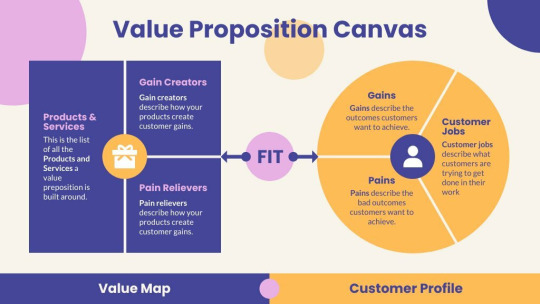
WHAT IS A VALUE PROPOSITION CANVAS?
The Value Proposition Canvas is a valuable tool used to gain a deeper understanding of your customers and create a compelling value proposition for your product or service. It begins by identifying the needs of your target customers, which can be both functional and emotional in nature. These are the things your customers actively seek or desire. Simultaneously, it's crucial to grasp their pains or challenges, which are the problems and inconveniences they encounter in their lives. Pains can be related to cost, time, effort, risks, or other hindrances.
With a clear understanding of customer needs and pains, you can then analyze how your product or service can effectively address these issues. This involves highlighting the features, capabilities, and attributes of your offering that directly alleviate customer pains and fulfill their needs. This alignment between what the customers seek and what your product provides is where the value proposition comes into play.
The value proposition is the central element of this framework, serving as a promise to your customers that your product will satisfactorily meet their needs and alleviate their pains. It's a concise and compelling statement that communicates the unique value your product offers to customers. In essence, it answers the question: "Why should a customer choose our product over alternatives?" This value proposition assures potential customers that they will gain value from using your product, ultimately increasing the likelihood of successful product adoption.
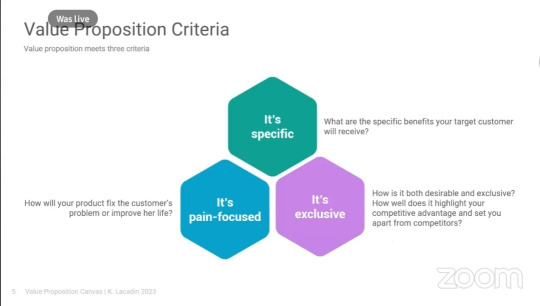
VALUE PROPOSITION CRITERIA
IT'S SPECIFIC
A specific value proposition effectively conveys the merits and benefits of your product or service without resorting to vague or generic language. It is tailored to a clearly defined target audience, addressing their specific needs and desires. This level of specificity aids potential customers in gaining a clear understanding of what they can anticipate from your offering.
IT'S PAIN-FOCUSED
A value proposition centered on addressing pain points identifies and tackles the specific issues or difficulties that your intended customers encounter. It showcases how your product or service can ease these pain points or offer solutions. This understanding and empathy for your customers' challenges enable you to establish a deeper connection with them.
IT'S EXCLUSIVE
An exclusive value proposition emphasizes the unique qualities that set your product or service apart from competitors. It effectively conveys the reasons why customers should select your offering over alternatives available in the market. This distinctiveness can arise from various aspects, including features, advantages, quality, or any distinguishing factor that differentiates your offering.
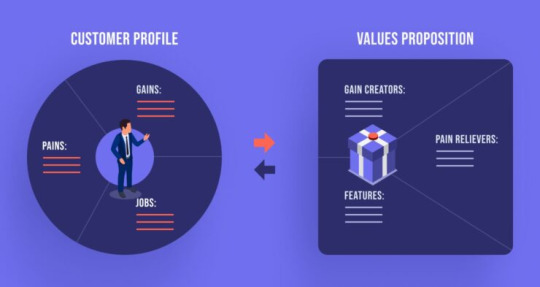
TWO CATEGORIES OF VALUE PROPOSITION CANVAS
CUSTOMER PROFILE
A customer profile is a fundamental component of any business or marketing strategy, with its primary focus on gaining a deep understanding of the customer's perspective. It involves the systematic collection and analysis of pertinent information to construct a detailed and comprehensive portrait of the typical or ideal customer for a product or service. This profile encompasses various dimensions, including demographic details like age, gender, location, income, and occupation, providing the foundation for effective customer segmentation. Furthermore, it delves into psychographic information, exploring lifestyle, values, interests, and behaviors, painting a holistic picture of customer motivations and aspirations.
In addition to demographic and psychographic data, a well-constructed customer profile delves into the specific needs and pain points of the customer. It seeks to uncover the problems customers are attempting to solve and their overarching goals. By identifying these aspects, businesses can position their products or services as effective solutions, creating a stronger connection with the customer.
Understanding the customer's buying behavior is another critical facet of a customer profile. This entails analyzing the processes and factors that influence their purchasing decisions. It helps businesses align their marketing and sales strategies with the preferences and habits of their target audience. Also, customer profiles encompass insights into how customers prefer to communicate with brands and their interactions with competitors, offering a comprehensive view of their engagement preferences and potential gaps in the market.
VALUES PROPOSITION/MAP
The "Value Map" is an integral part of any well-structured business strategy, serving as the connective tissue between a customer profile and the product or service being offered. It plays a vital role in detailing how the offerings align with the characteristics, needs, and preferences of the target audience as identified in the customer profile. This alignment is a strategic imperative, as it helps businesses develop a clear and compelling value proposition that resonates with their customers. By establishing this connection, the value map accomplishes several key objectives.
Firstly, it bridges the gap between customer requirements and the product's attributes, ensuring that the offerings effectively meet the needs, desires, and pain points discerned from the customer profile. Secondly, it enables businesses to tailor their value proposition in a way that speaks directly to the specific attributes most valued by their audience. The value map is not just about addressing customer needs but doing so in a manner that distinguishes the offering from competitors. This involves emphasizing unique selling points, whether they involve distinctive features, superior quality, cost-effectiveness, or any other factors that set the product apart.
Furthermore, the value map lays the groundwork for crafting a persuasive value proposition. This proposition is a concise and compelling statement that communicates the distinct value the product provides to the customer. It assures potential customers that the offering will fulfill their needs and alleviate their pains. Importantly, the value map is not a static document; it's part of an ongoing, iterative process. Businesses continuously refine their offerings to ensure that they remain closely aligned with customer expectations. By actively monitoring customer feedback and staying attuned to market trends, businesses can adapt their value maps to maintain relevance and competitiveness.
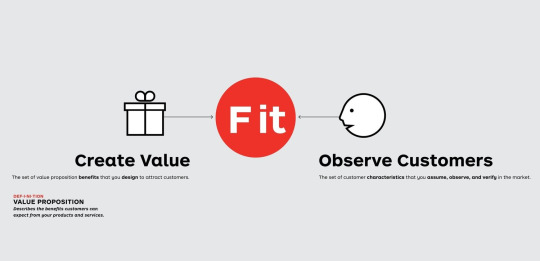
HOW TO CREATE A WINNING VALUE PROPOSITION
Step 1: Research Your Audience
In any successful marketing strategy, understanding your target audience is paramount. This involves delving deep into your potential customers' demographics, behaviors, preferences, and pain points. By doing so, you gain insights into what motivates them, what problems they need solutions for, and how your product or service can address these needs. This knowledge is essential for crafting effective marketing messages that resonate with your audience. It also allows you to pinpoint the selling points of your product or service, enabling you to tailor your communication in a way that highlights its unique benefits and value to your target market.
Step 2: Create an Ideal Buyer Persona
Once you've gathered extensive data about your audience, the next step is to distill this information into ideal buyer personas. A buyer persona is a semi-fictional representation of your ideal customer, and it encompasses key traits, behaviors, and preferences. Analyzing the qualitative data collected from your audience research allows you to identify patterns and commonalities among your potential customers. Creating different personas based on these patterns helps you categorize your audience into segments. This segmentation is valuable because it allows you to personalize your marketing efforts, tailoring your messages and offerings to suit the specific needs and desires of each persona. In essence, it makes your marketing more precise and effective.
Step 3: Research Your Competitors
Competitor research is not about undermining your competition, but rather, it's about gaining a comprehensive understanding of the market landscape. By studying your competitors, you can learn from their successes and failures, identify trends, and uncover opportunities for innovation. This step is essential for discovering a unique edge or advantage over the current offerings in the market. It involves analyzing your competitors' products, marketing strategies, pricing, customer feedback, and any gaps or weaknesses in their approach. This information can guide your own innovation and help you position your product or service more effectively.
Step 4: Determine the Primary Benefit of Your Product
The last step is you need to identify the core advantage of your product including the main value it provides to your customers. This primary benefit is the key reason why someone would choose your product over alternatives. It's essential to understand and clearly communicate this benefit in your marketing efforts.
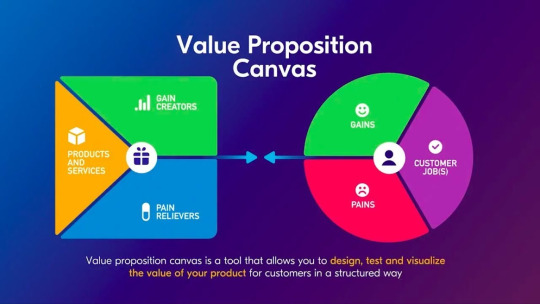
SUMMARY
he Value Proposition Canvas (VPC) is a powerful tool used to gain a deep understanding of customers and create a compelling value proposition for a product or service. It involves identifying customer needs and pains, which can be both functional and emotional. Needs are what customers actively seek, while pains are the problems and inconveniences they encounter. The VPC then guides you to analyze how your product can effectively address these issues by aligning its features with customer needs and pains. The value proposition serves as a promise to customers, assuring them that your product will meet their needs and alleviate their pains.
A winning value proposition should be specific, pain-focused, and exclusive. It should convey the merits and benefits of your product or service in a clear and tailored manner, addressing the specific needs and challenges of your target audience while emphasizing what sets your offering apart from competitors.
The process involves two categories: the Customer Profile and the Value Map. The Customer Profile delves into customer demographics, psychographics, needs, pain points, and buying behavior. The Value Map connects this customer understanding with your product's attributes, ensuring alignment with customer expectations. It also helps create a concise and compelling value proposition.
CONCLUSION
Creating a strong value proposition is essential for any business aiming to succeed in a competitive marketplace. The Value Proposition Canvas provides a structured approach to understanding customer needs and pains, aligning them with your product's features, and crafting a persuasive value proposition. By researching your audience, creating ideal buyer personas, and researching your competitors, you can gather the insights necessary to differentiate your product and communicate its unique value effectively. Ultimately, a well-crafted value proposition not only attracts potential customers but also fosters a deeper connection by addressing their specific needs and challenges, setting the stage for successful product adoption and business growth.
Written by: Jovy Rañesis
2 notes
·
View notes